QUT NSB334: Online Healthcare Modules - Michelle Bennet Case Study
VerifiedAdded on 2023/04/22
|13
|3135
|427
Homework Assignment
AI Summary
This assignment addresses a case study of Michelle Bennet, a 38-year-old diagnosed with triple-negative breast cancer. The assignment explores the challenges of uncertainty, fear of treatment, and the impact of the disease on her life. It covers the diagnosis, symptoms, and treatment options, including chemotherapy and radiotherapy. The assignment also delves into the pathophysiology of cancer pain, breathlessness, and the importance of resuscitation planning. Furthermore, it examines the role of support groups, counseling, and advanced health directives in patient care. The student provides short-term goals for the patient and discusses the role of the palliative team in managing the disease and improving the quality of life. The assignment also includes signs and symptoms of improvement and the distress experienced by cancer patients.
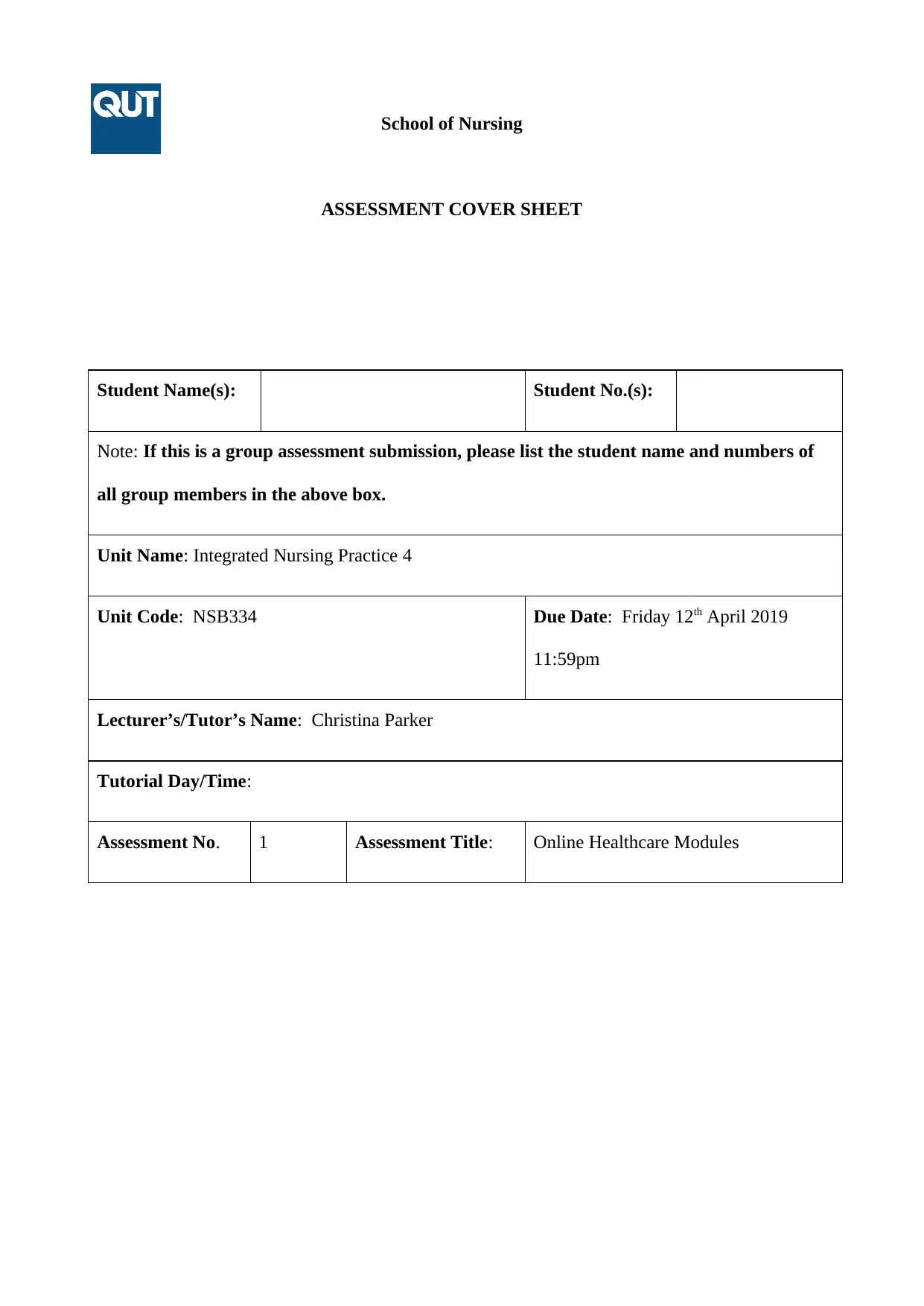
School of Nursing
ASSESSMENT COVER SHEET
Student Name(s): Student No.(s):
Note: If this is a group assessment submission, please list the student name and numbers of
all group members in the above box.
Unit Name: Integrated Nursing Practice 4
Unit Code: NSB334 Due Date: Friday 12th April 2019
11:59pm
Lecturer’s/Tutor’s Name: Christina Parker
Tutorial Day/Time:
Assessment No. 1 Assessment Title: Online Healthcare Modules
ASSESSMENT COVER SHEET
Student Name(s): Student No.(s):
Note: If this is a group assessment submission, please list the student name and numbers of
all group members in the above box.
Unit Name: Integrated Nursing Practice 4
Unit Code: NSB334 Due Date: Friday 12th April 2019
11:59pm
Lecturer’s/Tutor’s Name: Christina Parker
Tutorial Day/Time:
Assessment No. 1 Assessment Title: Online Healthcare Modules
Paraphrase This Document
Need a fresh take? Get an instant paraphrase of this document with our AI Paraphraser

Question 1
a. Two years ago, Michele was diagnosed with breast cancer, this news overwhelmed her
and she felt her world had turned upside down. After treatment, cancer responded to
chemotherapy and she was relieved and glad that her life was balanced again. She was happy
with Pette her husband and her two kids. Two months later she started having coughs and
feeling breathless. After a visit to the hospital, the oncologist told her that the cough was not a
virus. The CT scans showed cancer had spread to the lungs and the liver. The physician stated
further that cancer was not curable.
The greatest challenge Michele faced was uncertainty about the future. In the first
place, she was full of hope for the future, family and her job. After the physician told her that
she might not survive cancer, she lost hope for the future. Causes for uncertainty include the
following.
i. Having to put plans into a hold.
Michele felt like she was unable to look into the future. Making plans was not easy. For
instance, it was hard devoting to a lunch date not knowing how she will be feeling. She had
difficulty planning for a family vacation since she couldn’t predict when she will be having
therapy (Cheang, Vudok, Badjik, & Leung, 2013).
ii. Fear about cancer treatment and its side effects.
Mitchel was scared of the side effects of treatment such as nausea and vomiting, pain and
fatigue. She felt like she was too dependent on Pette for cancer therapy. She was also not sure
if the treatment will work since cancer had spread.
b. Admitting the existence of the unknowns of cancer may make one feel afraid and
anxious. For instance, it may interrupt sleep and make it harder to concentrate at work.
Strategies that may help Michele cope with this particular challenge include the
following.
a. Two years ago, Michele was diagnosed with breast cancer, this news overwhelmed her
and she felt her world had turned upside down. After treatment, cancer responded to
chemotherapy and she was relieved and glad that her life was balanced again. She was happy
with Pette her husband and her two kids. Two months later she started having coughs and
feeling breathless. After a visit to the hospital, the oncologist told her that the cough was not a
virus. The CT scans showed cancer had spread to the lungs and the liver. The physician stated
further that cancer was not curable.
The greatest challenge Michele faced was uncertainty about the future. In the first
place, she was full of hope for the future, family and her job. After the physician told her that
she might not survive cancer, she lost hope for the future. Causes for uncertainty include the
following.
i. Having to put plans into a hold.
Michele felt like she was unable to look into the future. Making plans was not easy. For
instance, it was hard devoting to a lunch date not knowing how she will be feeling. She had
difficulty planning for a family vacation since she couldn’t predict when she will be having
therapy (Cheang, Vudok, Badjik, & Leung, 2013).
ii. Fear about cancer treatment and its side effects.
Mitchel was scared of the side effects of treatment such as nausea and vomiting, pain and
fatigue. She felt like she was too dependent on Pette for cancer therapy. She was also not sure
if the treatment will work since cancer had spread.
b. Admitting the existence of the unknowns of cancer may make one feel afraid and
anxious. For instance, it may interrupt sleep and make it harder to concentrate at work.
Strategies that may help Michele cope with this particular challenge include the
following.

i. Joining support groups
Support groups help many individuals deal with the emotional issues of cancer by
providing a peaceful environment to share and manage their feelings and challenges.
Talking to the patient can reduce stress and it also creates a sense of belonging that
helps an individual feel more understood and less alone (Delaney, Colvin, &
Fleetwood, 2013).
ii. Individual counseling
Counseling helps the individual discover ways to cope with cancer. She is also able
to manage anxiety and depression, cancer symptoms and treatment side effects.
Counseling helps the individual talk about financial concerns and establish helpful
resources and lastly one gets to learn how to assist the family to understand and adapt
to changes in routine (Cheang, Vudok, Badjik, & Leung, 2013).
Question two
a. Triple-negative breast cancer is a kind of breast cancer that tests negative for
estrogen and progesterone receptors and excess HER2 protein. These results suggest
that cancer is not caused by HER2 protein, estrogen, and progesterone. So, triple
negative cancer does not show a response to hormonal therapy medicines that target
HER2 protein receptors. This implied that Michele couldn't recover from cancer since
there was no cure for it. The only thing that had remained for her was the management
of symptoms which included neoadjuvant chemotherapy and adjuvant chemotherapy
(Colvin & Fallon, 2017).
Question three
a. signs and symptoms
i. Lump or thickening of the breast tissue. The lump may be firmly attached to the skin
on top, chest wall or structures beneath it (Gotzsche & Jorgensen, 2014).
ii. Breast pain, warmth, and irritation which is not related to periods
Support groups help many individuals deal with the emotional issues of cancer by
providing a peaceful environment to share and manage their feelings and challenges.
Talking to the patient can reduce stress and it also creates a sense of belonging that
helps an individual feel more understood and less alone (Delaney, Colvin, &
Fleetwood, 2013).
ii. Individual counseling
Counseling helps the individual discover ways to cope with cancer. She is also able
to manage anxiety and depression, cancer symptoms and treatment side effects.
Counseling helps the individual talk about financial concerns and establish helpful
resources and lastly one gets to learn how to assist the family to understand and adapt
to changes in routine (Cheang, Vudok, Badjik, & Leung, 2013).
Question two
a. Triple-negative breast cancer is a kind of breast cancer that tests negative for
estrogen and progesterone receptors and excess HER2 protein. These results suggest
that cancer is not caused by HER2 protein, estrogen, and progesterone. So, triple
negative cancer does not show a response to hormonal therapy medicines that target
HER2 protein receptors. This implied that Michele couldn't recover from cancer since
there was no cure for it. The only thing that had remained for her was the management
of symptoms which included neoadjuvant chemotherapy and adjuvant chemotherapy
(Colvin & Fallon, 2017).
Question three
a. signs and symptoms
i. Lump or thickening of the breast tissue. The lump may be firmly attached to the skin
on top, chest wall or structures beneath it (Gotzsche & Jorgensen, 2014).
ii. Breast pain, warmth, and irritation which is not related to periods
⊘ This is a preview!⊘
Do you want full access?
Subscribe today to unlock all pages.

Trusted by 1+ million students worldwide

iii. A nipple that turns inwards
iv. Formation of dimples on the skin of the breast particularly when the hands are raised.
This is caused by attachment of the tumor to the skin overlying it. The dimples convey
a pitted appearance and a skin color change called peae d’orange (Gotzsche &
Jorgensen, 2014).
b. Pain experienced by cancer patient maybe disease or treatment related. The
pathophysiology of cancer pain is as follows. A tumor may cause pain in the breast or
spread of cancer to other parts of the body. Cancer cells in the breast secrets
interleukins, growth factors, and prostaglandins which facilitate pain transmission.
Tumor expansion can also inflict pressure on surrounding organs damaging the nerve
tissues which may lead to neuropathic pain.
Spread of cancer to other parts of the body may be the second cause of pain. For
example, if cancer has spread to the lung the patient will start experiencing chest pain.
If it spreads to the liver, an individual will experience pain in the upper right part of the
abdomen (Gotzsche & Jorgensen, 2014).
Question four
a. Computerized tomography scan
A CT scan is an X-ray technique that shows a 2-dimensional of body’s internal organs. It’s
often used to check if the breast cancer has spread to other internal organs. It helps decide if
the breast cancer can be removed through a mastectomy. Before the test, a die is injected into
the arm. A scan is conducted to check other parts of the body since cancer can spread to organs
such as liver, lungs, lymph nodes and spine (Nelson, Cantor, & Griffin, 2012).
b. The test showed that cancer had spread to the lungs and the liver. Breast cancer can
spread when the cell detaches from the tumor and travel to distant regions such as lungs
and liver through the bloodstream or lymphatics. This process is called metastasis.
c. From the results, the cancer has advanced to stage four. It means that cancer has
metastasized to other parts of the body. At this stage, the cancer is not curable and the
iv. Formation of dimples on the skin of the breast particularly when the hands are raised.
This is caused by attachment of the tumor to the skin overlying it. The dimples convey
a pitted appearance and a skin color change called peae d’orange (Gotzsche &
Jorgensen, 2014).
b. Pain experienced by cancer patient maybe disease or treatment related. The
pathophysiology of cancer pain is as follows. A tumor may cause pain in the breast or
spread of cancer to other parts of the body. Cancer cells in the breast secrets
interleukins, growth factors, and prostaglandins which facilitate pain transmission.
Tumor expansion can also inflict pressure on surrounding organs damaging the nerve
tissues which may lead to neuropathic pain.
Spread of cancer to other parts of the body may be the second cause of pain. For
example, if cancer has spread to the lung the patient will start experiencing chest pain.
If it spreads to the liver, an individual will experience pain in the upper right part of the
abdomen (Gotzsche & Jorgensen, 2014).
Question four
a. Computerized tomography scan
A CT scan is an X-ray technique that shows a 2-dimensional of body’s internal organs. It’s
often used to check if the breast cancer has spread to other internal organs. It helps decide if
the breast cancer can be removed through a mastectomy. Before the test, a die is injected into
the arm. A scan is conducted to check other parts of the body since cancer can spread to organs
such as liver, lungs, lymph nodes and spine (Nelson, Cantor, & Griffin, 2012).
b. The test showed that cancer had spread to the lungs and the liver. Breast cancer can
spread when the cell detaches from the tumor and travel to distant regions such as lungs
and liver through the bloodstream or lymphatics. This process is called metastasis.
c. From the results, the cancer has advanced to stage four. It means that cancer has
metastasized to other parts of the body. At this stage, the cancer is not curable and the
Paraphrase This Document
Need a fresh take? Get an instant paraphrase of this document with our AI Paraphraser
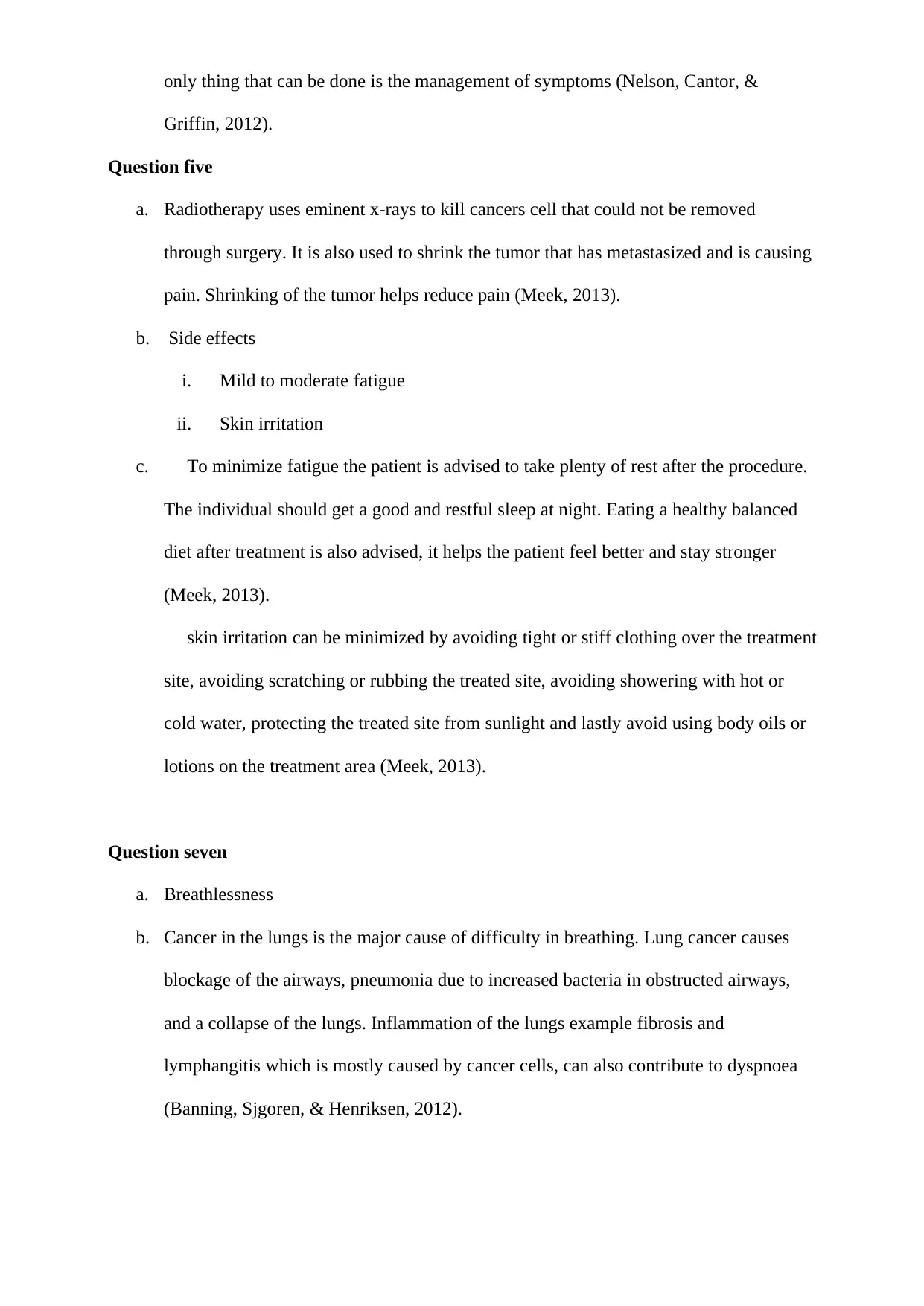
only thing that can be done is the management of symptoms (Nelson, Cantor, &
Griffin, 2012).
Question five
a. Radiotherapy uses eminent x-rays to kill cancers cell that could not be removed
through surgery. It is also used to shrink the tumor that has metastasized and is causing
pain. Shrinking of the tumor helps reduce pain (Meek, 2013).
b. Side effects
i. Mild to moderate fatigue
ii. Skin irritation
c. To minimize fatigue the patient is advised to take plenty of rest after the procedure.
The individual should get a good and restful sleep at night. Eating a healthy balanced
diet after treatment is also advised, it helps the patient feel better and stay stronger
(Meek, 2013).
skin irritation can be minimized by avoiding tight or stiff clothing over the treatment
site, avoiding scratching or rubbing the treated site, avoiding showering with hot or
cold water, protecting the treated site from sunlight and lastly avoid using body oils or
lotions on the treatment area (Meek, 2013).
Question seven
a. Breathlessness
b. Cancer in the lungs is the major cause of difficulty in breathing. Lung cancer causes
blockage of the airways, pneumonia due to increased bacteria in obstructed airways,
and a collapse of the lungs. Inflammation of the lungs example fibrosis and
lymphangitis which is mostly caused by cancer cells, can also contribute to dyspnoea
(Banning, Sjgoren, & Henriksen, 2012).
Griffin, 2012).
Question five
a. Radiotherapy uses eminent x-rays to kill cancers cell that could not be removed
through surgery. It is also used to shrink the tumor that has metastasized and is causing
pain. Shrinking of the tumor helps reduce pain (Meek, 2013).
b. Side effects
i. Mild to moderate fatigue
ii. Skin irritation
c. To minimize fatigue the patient is advised to take plenty of rest after the procedure.
The individual should get a good and restful sleep at night. Eating a healthy balanced
diet after treatment is also advised, it helps the patient feel better and stay stronger
(Meek, 2013).
skin irritation can be minimized by avoiding tight or stiff clothing over the treatment
site, avoiding scratching or rubbing the treated site, avoiding showering with hot or
cold water, protecting the treated site from sunlight and lastly avoid using body oils or
lotions on the treatment area (Meek, 2013).
Question seven
a. Breathlessness
b. Cancer in the lungs is the major cause of difficulty in breathing. Lung cancer causes
blockage of the airways, pneumonia due to increased bacteria in obstructed airways,
and a collapse of the lungs. Inflammation of the lungs example fibrosis and
lymphangitis which is mostly caused by cancer cells, can also contribute to dyspnoea
(Banning, Sjgoren, & Henriksen, 2012).

Question eight
a. Resuscitation planning is vital to the care of patients in a hospital. It is a medical
order signed by a physician and designed to give clinical direction in a situation in
which the client is in acute deterioration. ARP entails diagnosis, proposed resuscitation
plan in case the client deteriorates, alternative decision makers and lastly choices on
life-sustaining measures example refusing cardiopulmonary resuscitation (Wanscher,
Kober, & Lippert, 2012).
Question nine
a. Michelle’s problem
i. Acute pain
ii. Breathlessness
iii. Persistent cough
b. Acute pain is an awful emotional and sensory experience arising from potential
tissue damage. Pain may be related to nerve tissue compression caused by a tumor, side
effects of cancer therapy or inflammation. Uncontrolled pain is a problem since it
causes excess glucocorticoid and catecholamine’s production which may lead to
hypertension and tachycardia (Caraceni, Martini, & Portenoy, 2014).
Lung cancer is the major cause of breathlessness due to blockage of airways by
cancer cells. Difficulty in breathing can be a problem since it may increase the risk of
getting a heart disease such as angina, pulmonary hypertension, and anxiety (Caraceni,
Martini, & Portenoy, 2014).
Radiotherapy and chemotherapy are the major cause of cough. Cancer cells can
cause lung collapse which is manifested by coughing. Persistent coughing is a problem
since it facilitates lung damage, fractured ribs, syncope and dizziness (Caraceni,
Martini, & Portenoy, 2014).
a. Resuscitation planning is vital to the care of patients in a hospital. It is a medical
order signed by a physician and designed to give clinical direction in a situation in
which the client is in acute deterioration. ARP entails diagnosis, proposed resuscitation
plan in case the client deteriorates, alternative decision makers and lastly choices on
life-sustaining measures example refusing cardiopulmonary resuscitation (Wanscher,
Kober, & Lippert, 2012).
Question nine
a. Michelle’s problem
i. Acute pain
ii. Breathlessness
iii. Persistent cough
b. Acute pain is an awful emotional and sensory experience arising from potential
tissue damage. Pain may be related to nerve tissue compression caused by a tumor, side
effects of cancer therapy or inflammation. Uncontrolled pain is a problem since it
causes excess glucocorticoid and catecholamine’s production which may lead to
hypertension and tachycardia (Caraceni, Martini, & Portenoy, 2014).
Lung cancer is the major cause of breathlessness due to blockage of airways by
cancer cells. Difficulty in breathing can be a problem since it may increase the risk of
getting a heart disease such as angina, pulmonary hypertension, and anxiety (Caraceni,
Martini, & Portenoy, 2014).
Radiotherapy and chemotherapy are the major cause of cough. Cancer cells can
cause lung collapse which is manifested by coughing. Persistent coughing is a problem
since it facilitates lung damage, fractured ribs, syncope and dizziness (Caraceni,
Martini, & Portenoy, 2014).
⊘ This is a preview!⊘
Do you want full access?
Subscribe today to unlock all pages.

Trusted by 1+ million students worldwide
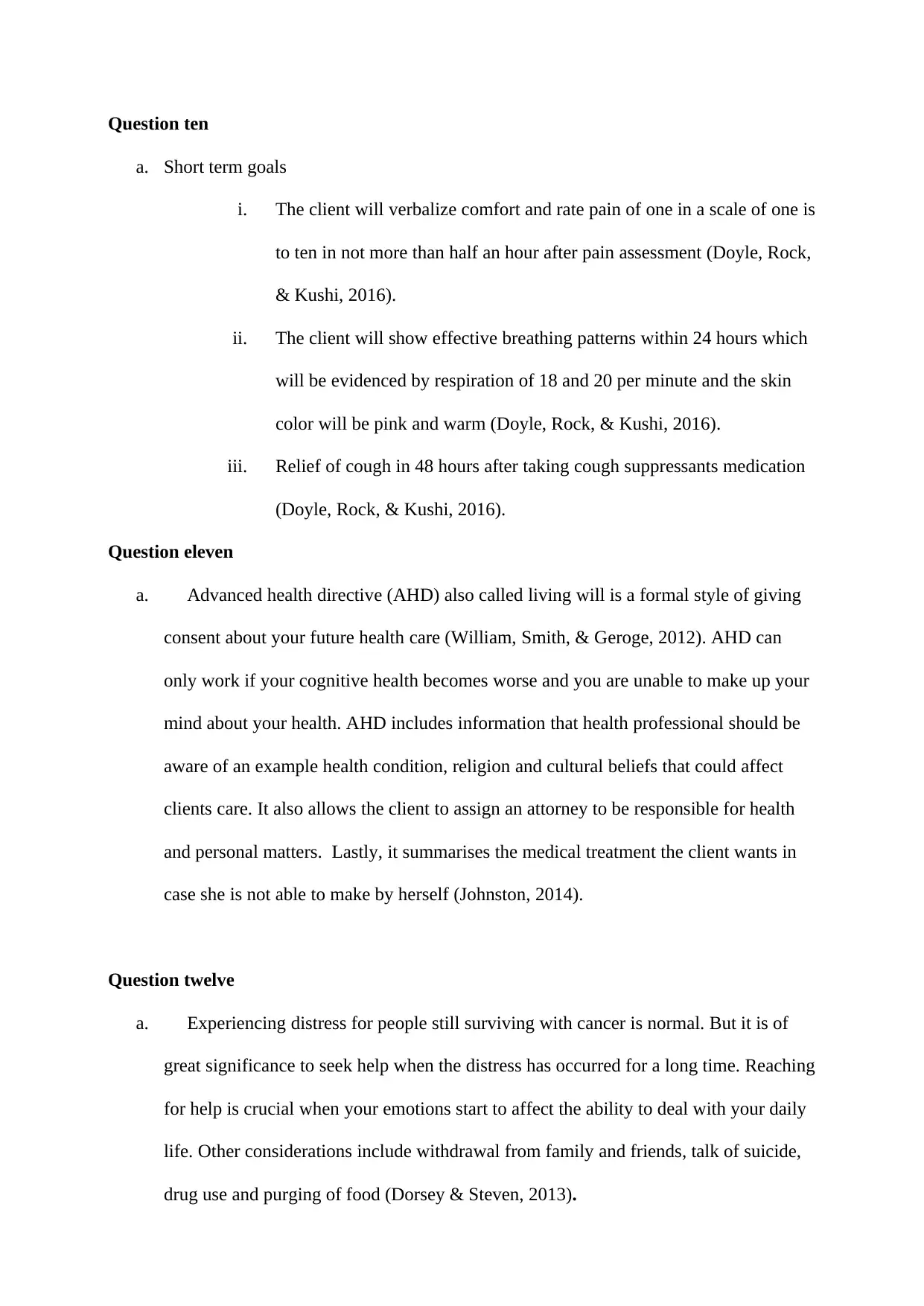
Question ten
a. Short term goals
i. The client will verbalize comfort and rate pain of one in a scale of one is
to ten in not more than half an hour after pain assessment (Doyle, Rock,
& Kushi, 2016).
ii. The client will show effective breathing patterns within 24 hours which
will be evidenced by respiration of 18 and 20 per minute and the skin
color will be pink and warm (Doyle, Rock, & Kushi, 2016).
iii. Relief of cough in 48 hours after taking cough suppressants medication
(Doyle, Rock, & Kushi, 2016).
Question eleven
a. Advanced health directive (AHD) also called living will is a formal style of giving
consent about your future health care (William, Smith, & Geroge, 2012). AHD can
only work if your cognitive health becomes worse and you are unable to make up your
mind about your health. AHD includes information that health professional should be
aware of an example health condition, religion and cultural beliefs that could affect
clients care. It also allows the client to assign an attorney to be responsible for health
and personal matters. Lastly, it summarises the medical treatment the client wants in
case she is not able to make by herself (Johnston, 2014).
Question twelve
a. Experiencing distress for people still surviving with cancer is normal. But it is of
great significance to seek help when the distress has occurred for a long time. Reaching
for help is crucial when your emotions start to affect the ability to deal with your daily
life. Other considerations include withdrawal from family and friends, talk of suicide,
drug use and purging of food (Dorsey & Steven, 2013).
a. Short term goals
i. The client will verbalize comfort and rate pain of one in a scale of one is
to ten in not more than half an hour after pain assessment (Doyle, Rock,
& Kushi, 2016).
ii. The client will show effective breathing patterns within 24 hours which
will be evidenced by respiration of 18 and 20 per minute and the skin
color will be pink and warm (Doyle, Rock, & Kushi, 2016).
iii. Relief of cough in 48 hours after taking cough suppressants medication
(Doyle, Rock, & Kushi, 2016).
Question eleven
a. Advanced health directive (AHD) also called living will is a formal style of giving
consent about your future health care (William, Smith, & Geroge, 2012). AHD can
only work if your cognitive health becomes worse and you are unable to make up your
mind about your health. AHD includes information that health professional should be
aware of an example health condition, religion and cultural beliefs that could affect
clients care. It also allows the client to assign an attorney to be responsible for health
and personal matters. Lastly, it summarises the medical treatment the client wants in
case she is not able to make by herself (Johnston, 2014).
Question twelve
a. Experiencing distress for people still surviving with cancer is normal. But it is of
great significance to seek help when the distress has occurred for a long time. Reaching
for help is crucial when your emotions start to affect the ability to deal with your daily
life. Other considerations include withdrawal from family and friends, talk of suicide,
drug use and purging of food (Dorsey & Steven, 2013).
Paraphrase This Document
Need a fresh take? Get an instant paraphrase of this document with our AI Paraphraser
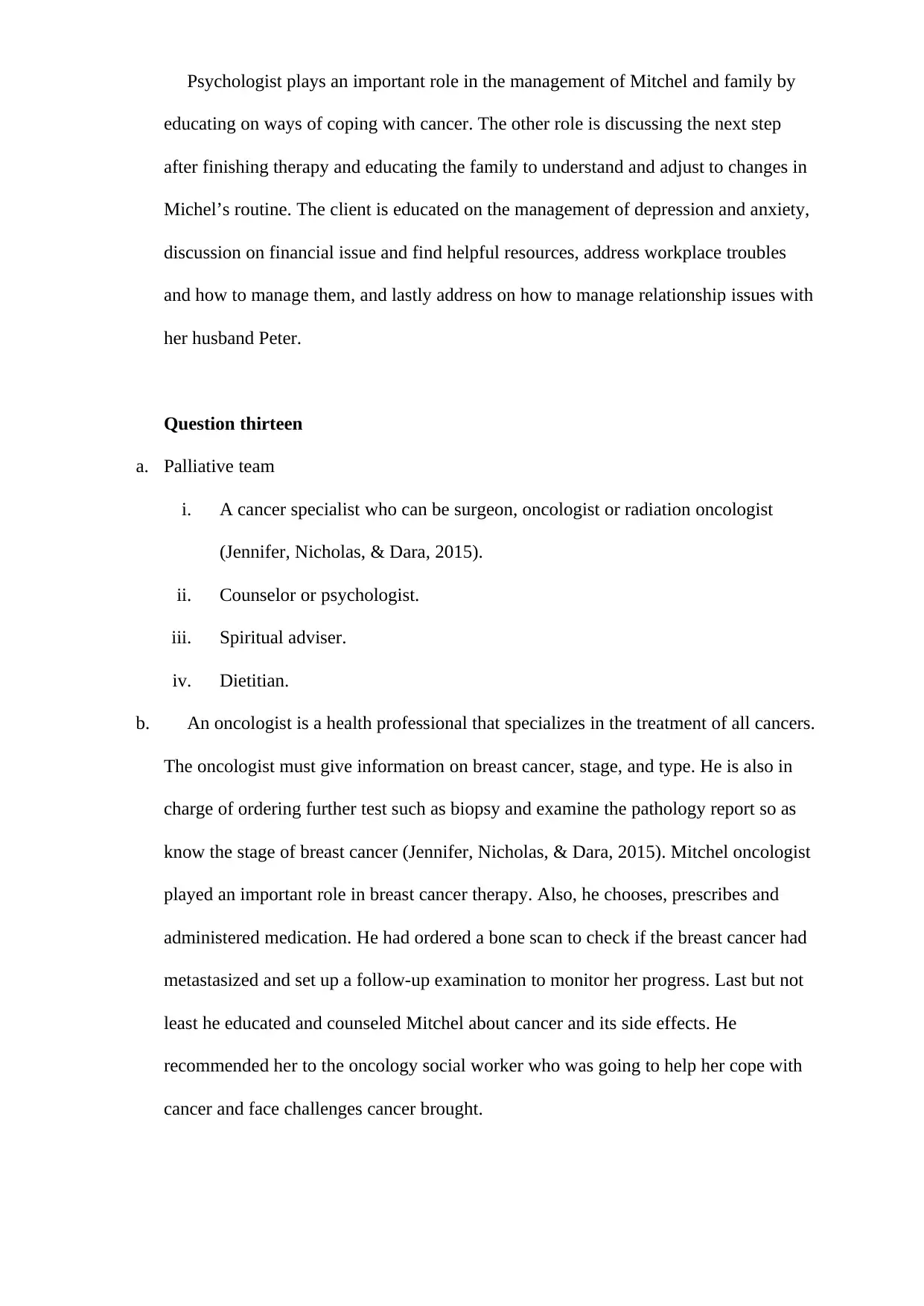
Psychologist plays an important role in the management of Mitchel and family by
educating on ways of coping with cancer. The other role is discussing the next step
after finishing therapy and educating the family to understand and adjust to changes in
Michel’s routine. The client is educated on the management of depression and anxiety,
discussion on financial issue and find helpful resources, address workplace troubles
and how to manage them, and lastly address on how to manage relationship issues with
her husband Peter.
Question thirteen
a. Palliative team
i. A cancer specialist who can be surgeon, oncologist or radiation oncologist
(Jennifer, Nicholas, & Dara, 2015).
ii. Counselor or psychologist.
iii. Spiritual adviser.
iv. Dietitian.
b. An oncologist is a health professional that specializes in the treatment of all cancers.
The oncologist must give information on breast cancer, stage, and type. He is also in
charge of ordering further test such as biopsy and examine the pathology report so as
know the stage of breast cancer (Jennifer, Nicholas, & Dara, 2015). Mitchel oncologist
played an important role in breast cancer therapy. Also, he chooses, prescribes and
administered medication. He had ordered a bone scan to check if the breast cancer had
metastasized and set up a follow-up examination to monitor her progress. Last but not
least he educated and counseled Mitchel about cancer and its side effects. He
recommended her to the oncology social worker who was going to help her cope with
cancer and face challenges cancer brought.
educating on ways of coping with cancer. The other role is discussing the next step
after finishing therapy and educating the family to understand and adjust to changes in
Michel’s routine. The client is educated on the management of depression and anxiety,
discussion on financial issue and find helpful resources, address workplace troubles
and how to manage them, and lastly address on how to manage relationship issues with
her husband Peter.
Question thirteen
a. Palliative team
i. A cancer specialist who can be surgeon, oncologist or radiation oncologist
(Jennifer, Nicholas, & Dara, 2015).
ii. Counselor or psychologist.
iii. Spiritual adviser.
iv. Dietitian.
b. An oncologist is a health professional that specializes in the treatment of all cancers.
The oncologist must give information on breast cancer, stage, and type. He is also in
charge of ordering further test such as biopsy and examine the pathology report so as
know the stage of breast cancer (Jennifer, Nicholas, & Dara, 2015). Mitchel oncologist
played an important role in breast cancer therapy. Also, he chooses, prescribes and
administered medication. He had ordered a bone scan to check if the breast cancer had
metastasized and set up a follow-up examination to monitor her progress. Last but not
least he educated and counseled Mitchel about cancer and its side effects. He
recommended her to the oncology social worker who was going to help her cope with
cancer and face challenges cancer brought.

Question fourteen
a. Signs and symptoms
i. The client reports decreased pain.
ii. Reduced dyspnoea.
iii. Fewer episodes of nausea and vomiting.
iv. Reduced coughing (Anand, Sundaram, & Tharakan, 2014).
b. Mitchel is verbalizing less pain, she takes pain medication at the right time, she
demonstrates reduced behavioral and physical signs of pain, recognizes the previous
actions that provoked pain. The client shows relaxation skills and various activities as
suggested for an individual situation (Anand, Sundaram, & Tharakan, 2014).
Question fifteen
a. The self-care strategy that I might use is maintaining good health and be stress-free
(Brayzke, 2012).
b. It is good to put your own needs last, but it is also important to look after yourself
when you feel tired or stressed. Poor health will affect an individual ability to take care
of the person that needs you the most. A good physical and emotional well-being can
be enhanced by taking regular breaks to avoid becoming worn out, sleeping well,
exercising, and lastly eating a healthy balanced diet. Looking after your health enables
the caregiver to have the energy and vitality she needs to take care of her patients
(Brayzke, 2012).
a. Signs and symptoms
i. The client reports decreased pain.
ii. Reduced dyspnoea.
iii. Fewer episodes of nausea and vomiting.
iv. Reduced coughing (Anand, Sundaram, & Tharakan, 2014).
b. Mitchel is verbalizing less pain, she takes pain medication at the right time, she
demonstrates reduced behavioral and physical signs of pain, recognizes the previous
actions that provoked pain. The client shows relaxation skills and various activities as
suggested for an individual situation (Anand, Sundaram, & Tharakan, 2014).
Question fifteen
a. The self-care strategy that I might use is maintaining good health and be stress-free
(Brayzke, 2012).
b. It is good to put your own needs last, but it is also important to look after yourself
when you feel tired or stressed. Poor health will affect an individual ability to take care
of the person that needs you the most. A good physical and emotional well-being can
be enhanced by taking regular breaks to avoid becoming worn out, sleeping well,
exercising, and lastly eating a healthy balanced diet. Looking after your health enables
the caregiver to have the energy and vitality she needs to take care of her patients
(Brayzke, 2012).
⊘ This is a preview!⊘
Do you want full access?
Subscribe today to unlock all pages.

Trusted by 1+ million students worldwide
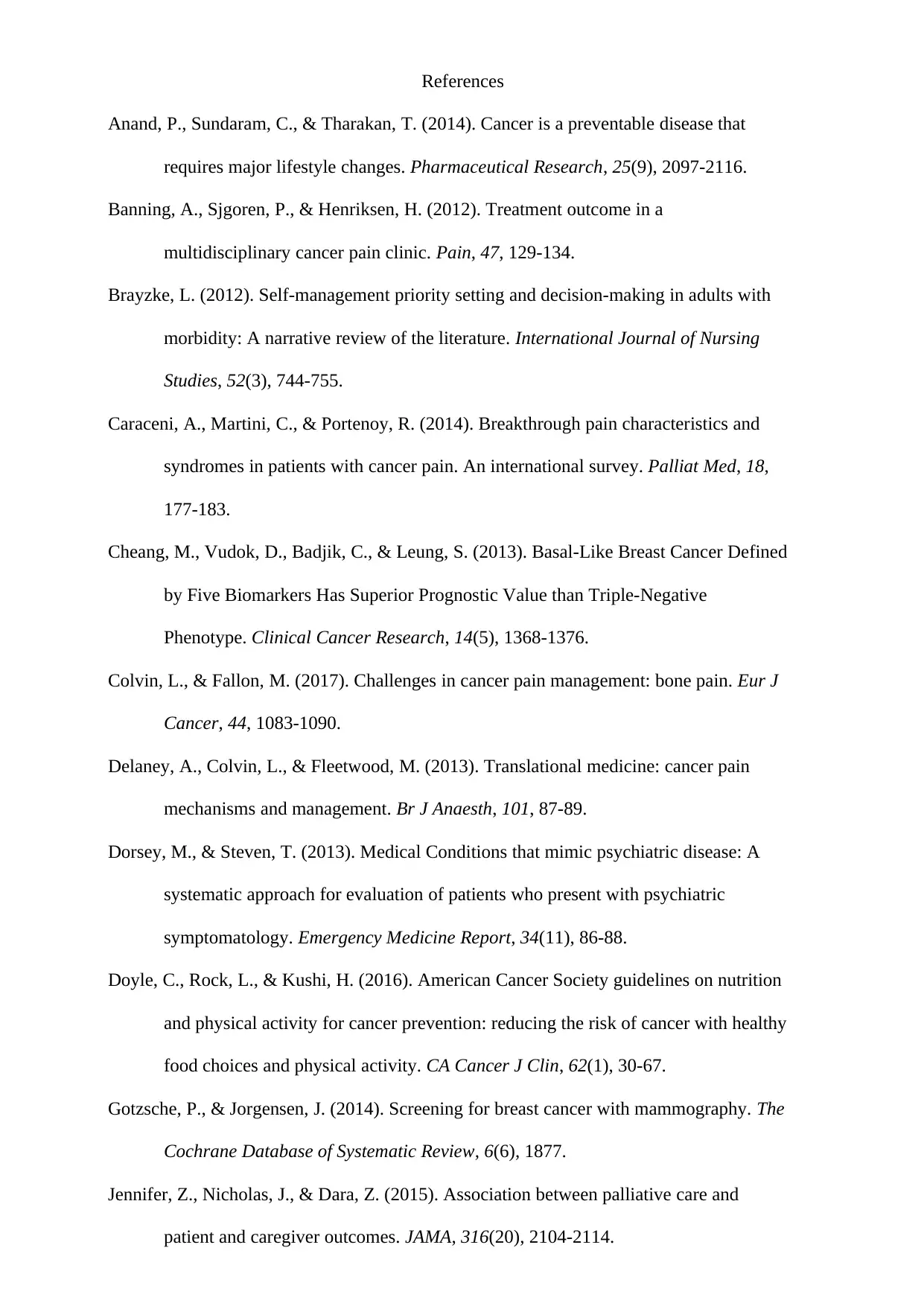
References
Anand, P., Sundaram, C., & Tharakan, T. (2014). Cancer is a preventable disease that
requires major lifestyle changes. Pharmaceutical Research, 25(9), 2097-2116.
Banning, A., Sjgoren, P., & Henriksen, H. (2012). Treatment outcome in a
multidisciplinary cancer pain clinic. Pain, 47, 129-134.
Brayzke, L. (2012). Self-management priority setting and decision-making in adults with
morbidity: A narrative review of the literature. International Journal of Nursing
Studies, 52(3), 744-755.
Caraceni, A., Martini, C., & Portenoy, R. (2014). Breakthrough pain characteristics and
syndromes in patients with cancer pain. An international survey. Palliat Med, 18,
177-183.
Cheang, M., Vudok, D., Badjik, C., & Leung, S. (2013). Basal-Like Breast Cancer Defined
by Five Biomarkers Has Superior Prognostic Value than Triple-Negative
Phenotype. Clinical Cancer Research, 14(5), 1368-1376.
Colvin, L., & Fallon, M. (2017). Challenges in cancer pain management: bone pain. Eur J
Cancer, 44, 1083-1090.
Delaney, A., Colvin, L., & Fleetwood, M. (2013). Translational medicine: cancer pain
mechanisms and management. Br J Anaesth, 101, 87-89.
Dorsey, M., & Steven, T. (2013). Medical Conditions that mimic psychiatric disease: A
systematic approach for evaluation of patients who present with psychiatric
symptomatology. Emergency Medicine Report, 34(11), 86-88.
Doyle, C., Rock, L., & Kushi, H. (2016). American Cancer Society guidelines on nutrition
and physical activity for cancer prevention: reducing the risk of cancer with healthy
food choices and physical activity. CA Cancer J Clin, 62(1), 30-67.
Gotzsche, P., & Jorgensen, J. (2014). Screening for breast cancer with mammography. The
Cochrane Database of Systematic Review, 6(6), 1877.
Jennifer, Z., Nicholas, J., & Dara, Z. (2015). Association between palliative care and
patient and caregiver outcomes. JAMA, 316(20), 2104-2114.
Anand, P., Sundaram, C., & Tharakan, T. (2014). Cancer is a preventable disease that
requires major lifestyle changes. Pharmaceutical Research, 25(9), 2097-2116.
Banning, A., Sjgoren, P., & Henriksen, H. (2012). Treatment outcome in a
multidisciplinary cancer pain clinic. Pain, 47, 129-134.
Brayzke, L. (2012). Self-management priority setting and decision-making in adults with
morbidity: A narrative review of the literature. International Journal of Nursing
Studies, 52(3), 744-755.
Caraceni, A., Martini, C., & Portenoy, R. (2014). Breakthrough pain characteristics and
syndromes in patients with cancer pain. An international survey. Palliat Med, 18,
177-183.
Cheang, M., Vudok, D., Badjik, C., & Leung, S. (2013). Basal-Like Breast Cancer Defined
by Five Biomarkers Has Superior Prognostic Value than Triple-Negative
Phenotype. Clinical Cancer Research, 14(5), 1368-1376.
Colvin, L., & Fallon, M. (2017). Challenges in cancer pain management: bone pain. Eur J
Cancer, 44, 1083-1090.
Delaney, A., Colvin, L., & Fleetwood, M. (2013). Translational medicine: cancer pain
mechanisms and management. Br J Anaesth, 101, 87-89.
Dorsey, M., & Steven, T. (2013). Medical Conditions that mimic psychiatric disease: A
systematic approach for evaluation of patients who present with psychiatric
symptomatology. Emergency Medicine Report, 34(11), 86-88.
Doyle, C., Rock, L., & Kushi, H. (2016). American Cancer Society guidelines on nutrition
and physical activity for cancer prevention: reducing the risk of cancer with healthy
food choices and physical activity. CA Cancer J Clin, 62(1), 30-67.
Gotzsche, P., & Jorgensen, J. (2014). Screening for breast cancer with mammography. The
Cochrane Database of Systematic Review, 6(6), 1877.
Jennifer, Z., Nicholas, J., & Dara, Z. (2015). Association between palliative care and
patient and caregiver outcomes. JAMA, 316(20), 2104-2114.
Paraphrase This Document
Need a fresh take? Get an instant paraphrase of this document with our AI Paraphraser
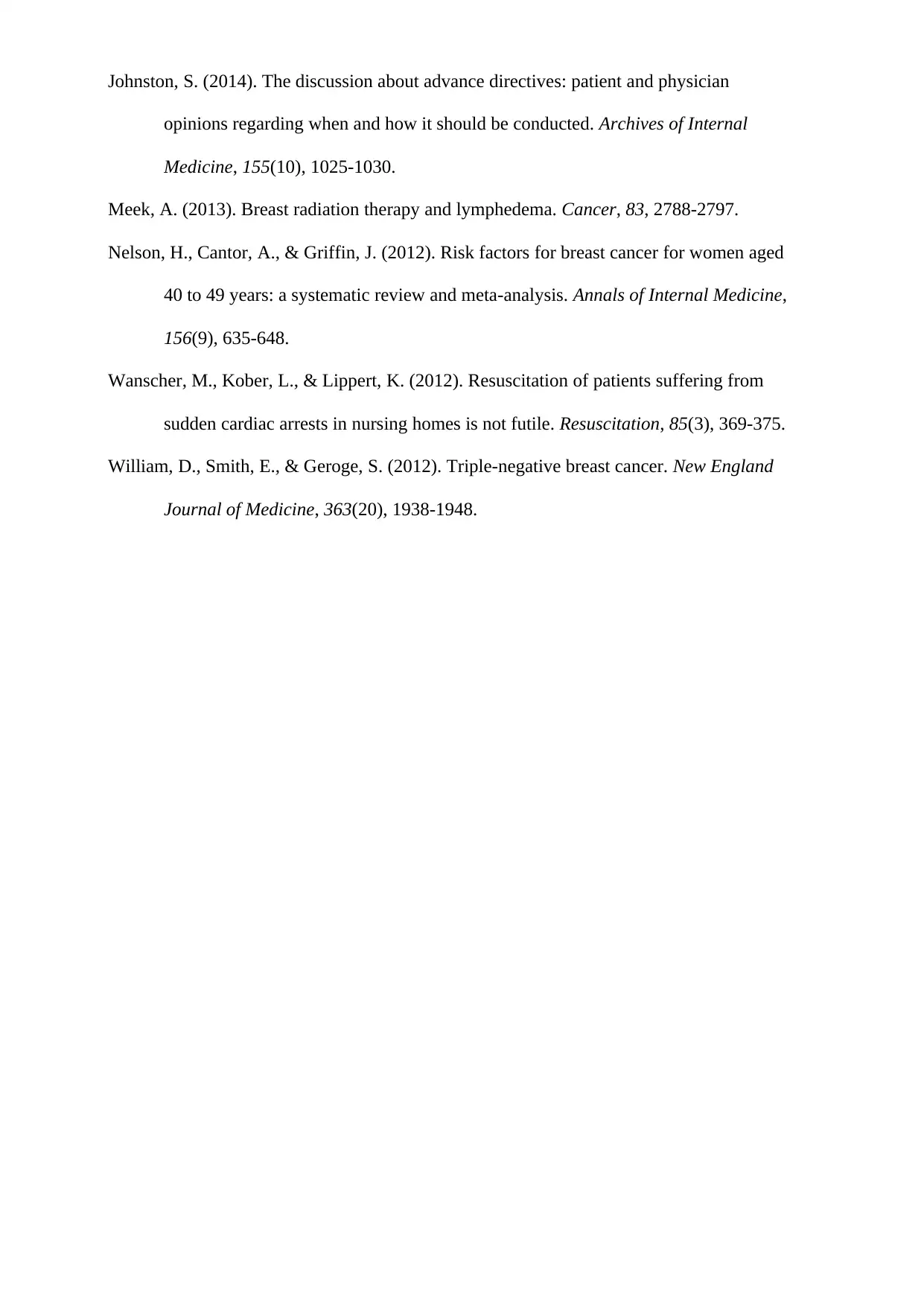
Johnston, S. (2014). The discussion about advance directives: patient and physician
opinions regarding when and how it should be conducted. Archives of Internal
Medicine, 155(10), 1025-1030.
Meek, A. (2013). Breast radiation therapy and lymphedema. Cancer, 83, 2788-2797.
Nelson, H., Cantor, A., & Griffin, J. (2012). Risk factors for breast cancer for women aged
40 to 49 years: a systematic review and meta-analysis. Annals of Internal Medicine,
156(9), 635-648.
Wanscher, M., Kober, L., & Lippert, K. (2012). Resuscitation of patients suffering from
sudden cardiac arrests in nursing homes is not futile. Resuscitation, 85(3), 369-375.
William, D., Smith, E., & Geroge, S. (2012). Triple-negative breast cancer. New England
Journal of Medicine, 363(20), 1938-1948.
opinions regarding when and how it should be conducted. Archives of Internal
Medicine, 155(10), 1025-1030.
Meek, A. (2013). Breast radiation therapy and lymphedema. Cancer, 83, 2788-2797.
Nelson, H., Cantor, A., & Griffin, J. (2012). Risk factors for breast cancer for women aged
40 to 49 years: a systematic review and meta-analysis. Annals of Internal Medicine,
156(9), 635-648.
Wanscher, M., Kober, L., & Lippert, K. (2012). Resuscitation of patients suffering from
sudden cardiac arrests in nursing homes is not futile. Resuscitation, 85(3), 369-375.
William, D., Smith, E., & Geroge, S. (2012). Triple-negative breast cancer. New England
Journal of Medicine, 363(20), 1938-1948.

⊘ This is a preview!⊘
Do you want full access?
Subscribe today to unlock all pages.

Trusted by 1+ million students worldwide
1 out of 13
Your All-in-One AI-Powered Toolkit for Academic Success.
+13062052269
info@desklib.com
Available 24*7 on WhatsApp / Email
![[object Object]](/_next/static/media/star-bottom.7253800d.svg)
Unlock your academic potential
Copyright © 2020–2025 A2Z Services. All Rights Reserved. Developed and managed by ZUCOL.

